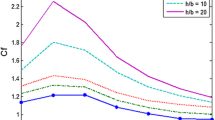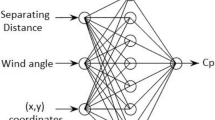Abstract
This paper presents the development of artificial neural network (ANN) model for predicting the dynamic across-wind response of tall building as per the provisions given in Indian Wind Code (IWC), IS 875 (Part-3):2015. IWC has given the procedure for estimating across-wind load response for limited aspect ratios of the building. For calculating the across-wind response not conforming to the ratios specified in the code, additional time-consuming and expensive studies are required. In order to minimise such tedious studies, an efficient computational technique is essential to determine wind response. ANN proves to be a promising alternative technique for analysing complex engineering problems. Thus, in this paper, using the best-fit model of ANN, predictions are made for the building configurations that are not included in IWC. The results are plotted as a series of charts in terms of base shear and the base bending moment. It is found that the predictions made using the trained and developed ANN models are in good agreement with the desired output.



















Similar content being viewed by others
Abbreviations
- \( M_{C} \) :
-
Across-wind design peak base bending moment
- z :
-
Any height of building/structure in m
- \( g_{h} \) :
-
Peak factor
- \( f_{\text{c}} \) :
-
The first-mode natural frequency of the building/structure in the crosswind direction in Hz
- \( \bar{V}_{\text{b}} \) :
-
Basic wind speed
- \( \bar{k}_{2,i} \) :
-
Hourly mean wind speed factor for terrain category
- \( k_{4} \) :
-
Importance factor for the cyclonic region
- \( I_{h,i} \) :
-
Turbulence intensity at height h in terrain category i
- \( C_{\text{fs}} \) :
-
Across-wind force spectrum coefficient
- h :
-
The height of building/structure in m
- b :
-
The breadth of the structure normal to the wind, in m
- \( \overline{{p_{h} }} \) :
-
Design hourly mean wind speed pressure corresponding to \( \overline{{V_{h,d} }} \)
- \( \bar{V}_{h,d} \) :
-
Design hourly mean wind speed at height h in m/s
- \( k_{1} \) :
-
Probability factor (risk coefficient)
- \( k_{3} \) :
-
Topography factor
- \( Z_{0,i} \) :
-
Equivalent aerodynamic roughness height
- k :
-
A mode shape power exponent
- β :
-
Damping coefficient of building/structure
References
Mendis P, Ngo T, Haritos N, Hira A (2007) Wind loading on tall buildings. EJSE Spec Issue Load Struct 41–54
Lin N, Letchford C, Tamujra Y, Liang B, Nakamura O (2005) Characteristics of wind force acting tall buildings. J Wind Eng Ind Aerodyn 93:217–242
Gu M (2009) Study on wind loads and response of tall buildings and structures. In: The Seventh Asia Pacific Conference on Wind Engineering, 8–12 November
Yang Z, Sarkar PP, Hu H (2011) An experimental study of a high-rise building model in tornado like winds. J Fluids Struct 27:471–486
Amin JK, Ahuja AK (2011) Experimental study of wind-induced pressure on buildings various geometries. Int J Sci Technol 3:1–19
Vanluchene RD, Roufei Sun (1990) Neural networks in structural engineering. Microcomput Civil Eng 5:207–215
Deshpande JM, Mukherjee A (1995) Artificial neural network in modelling structural stability of compression members. In: Proceeding International Conference on the Stability of Structures, ICSS
Janusz Kasperkiewicz, Janusz Racz, Artur Dubrawski (1995) HPS strength prediction using artificial neural network. J Comput Civ Eng 9(4):279–284
Roa MM, Datta TK (2006) Modelseismic control of building frames by artificial neural network. J Comput Civ Eng 20(1):69–73
Petroutsatou K, Georgopoulos E, Lambropoulos S, Pantouvakis JP (2012) Early cost estimating of road tunnel construction using neural networks. J Constr Eng Manag 138(6):679–687
Chokshi P, Dashwood R, Hughes DJ (2017) Artificial neural network (ANN) based microstructural prediction model for 22Mnb5 boron steel during tailored hot stamping. Comput Struct 190:162–172
Nejad FP, Jaksa MB (2017) Load-settlement behaviour modelling of single piles using artificial neural networks and CPT data. Comput Geotech 89:9–21
Bitsuamlak GT, Godbole PN (1999) Application of cascade correlation neural network for determination of wind pressure distribution in buildings. In: 10th International Conference on Industrial Aerodynamics and Wind Engineering, Denmark, pp 1491–1497
Kwatra N, Godbole PN, Krishna P (2002) Application of ANN for determination of wind-induced pressure on gable roof. Int J Wind Struct 5(1):1–14
Chen Y, Kopp GA, Surry D (2003) Prediction of pressure coefficients on roof of low buildings using artificial neural networking. J Wind Eng Ind Aerodyn 91:432–444
Bitsuamlak GT, Bedard C, Stathopoulos T (2006) Effects of upstream two-dimensional hills on design wind loads: a computational approach. Wind Struct 9(1):37–58
Bitsuamlak GT, Bedard C, Stathopoulos T (2007) Modeling the effect of topography on wind flow casing a combined numerical—neural network approach. ASCE J Comput Civ Eng 21(6):384–392
Elshaer A, Bitsuamlak GT, Damatty AE (2017) Enhancing wind performance of tall buildings using corner aerodynamics optimization. Eng Struct 136:133–148
IS 875 (Part-3):2015 (2015) Code of practice for design loads (other than earthquake) for buildings and structures—Part 3 wind loads, Bureau of Indian Standards, Manak Bhawan, New Delhi
Nikose TJ, Sonparote RS (2018) Dynamic along wind response of tall buildings using artificial neural network. Cluster Comput. https://doi.org/10.1007/s10586-018-2027-0
Author information
Authors and Affiliations
Corresponding author
Rights and permissions
About this article
Cite this article
Nikose, T.J., Sonparote, R.S. Computing dynamic across-wind response of tall buildings using artificial neural network. J Supercomput 76, 3788–3813 (2020). https://doi.org/10.1007/s11227-018-2708-8
Published:
Issue Date:
DOI: https://doi.org/10.1007/s11227-018-2708-8




